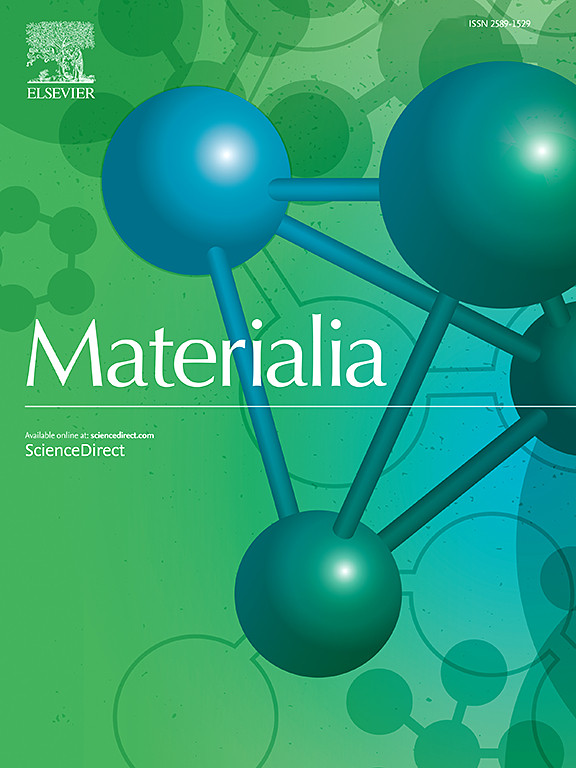具有蓝色持续发光的k掺杂二氧化硅纳米颗粒的合成和表征:一种新的溶胶-凝胶方法
IF 3
Q2 MATERIALS SCIENCE, MULTIDISCIPLINARY
引用次数: 0
摘要
虽然持续发光(PersL)材料有许多重要的应用,并且正在积极研究中,但蓝色发光荧光粉提出了最大的挑战和缺乏合适的材料。非晶二氧化硅(SiO2)具有化学稳定性好、透明度高、耐辐射、形状易调节等特点,在可作为蓝色发光材料的固体中脱颖而出。我们展示了一种新的、环保的方法来合成掺杂K离子的二氧化硅纳米粒子。用K离子(0.1;0.5;1.0和1.5在%)。在k掺杂样品中检测到最大465 nm (2.7 eV)和327 nm (3.8 eV)的强蓝色光致发光(PL),这在纯硅玻璃中通常不存在。在% K- K掺杂的0.1和0.5样品表现出持续一分钟的蓝色持续发光(PersL)。在掺有Na和K离子的多孔二氧化硅中也发现了类似的蓝色PL带,但没有发现纳米颗粒的形态和PL衰变动力学的信息。与室温相比,在100k和10k下,掺杂% K的样品的PL余辉随温度的变化略强,这表明它可以在更低的温度下使用。扫描电子显微镜(SEM)和能量色散x射线(EDX)微分析证实了K在非晶二氧化硅中的存在。K离子浓度的增加导致颗粒尺寸和聚集量的增大。本文章由计算机程序翻译,如有差异,请以英文原文为准。

Synthesis and Characterization of K-Doped SiO₂ nanoparticles with blue persistent luminescence: A novel approach using the sol-gel method
While persistent luminescence (PersL) materials have many important applications and are actively being studied, blue-emitting phosphors propose the biggest challenges and lack of suitable materials. Among any solids that can serve as blue emitting PersL matrices, amorphous silicon dioxide (SiO2) stands out with great chemical stability, high transparency, radiation resistance, and easly of adjusting the shape. We demonstrate a novel and environmentally friendly method for synthesising PersL SiO2 nanoparticles doped with K ions. Optical and morphological properties of amorphous silica nanoparticles were studied in the course of slightly doping pure silica with K ions (0.1; 0.5; 1.0 and 1.5 at%). An intensive blue photoluminescence (PL) with a maximum of 465 nm (2.7 eV) and another band at 327 nm (3.8 eV) were detected for K-doped samples, which is not normally present for pure silica glass. The 0.1 and 0.5 at% K- K-doped samples exhibit blue persistent luminescence (PersL) that lasts up to a minute. Similar blue PL bands have been reported for porous silicas doped with Na and K ions, but no information about the nanoparticle's morphology and PL decay kinetics has been discovered. The temperature-dependent PL afterglow for 0.5 at% K-doped sample is observed to be slightly more intense at 100 K and 10 K compared to room temperature, suggesting its use at lower temperatures. Scanning Electron Microscopy (SEM) with Energy Dispersive X-ray (EDX) microanalysis confirmed the presence of K in amorphous silica. Increasing the K ion concentration leads to larger particle size and aggregation.
求助全文
通过发布文献求助,成功后即可免费获取论文全文。
去求助
来源期刊

Materialia
MATERIALS SCIENCE, MULTIDISCIPLINARY-
CiteScore
6.40
自引率
2.90%
发文量
345
审稿时长
36 days
期刊介绍:
Materialia is a multidisciplinary journal of materials science and engineering that publishes original peer-reviewed research articles. Articles in Materialia advance the understanding of the relationship between processing, structure, property, and function of materials.
Materialia publishes full-length research articles, review articles, and letters (short communications). In addition to receiving direct submissions, Materialia also accepts transfers from Acta Materialia, Inc. partner journals. Materialia offers authors the choice to publish on an open access model (with author fee), or on a subscription model (with no author fee).
 求助内容:
求助内容: 应助结果提醒方式:
应助结果提醒方式:


